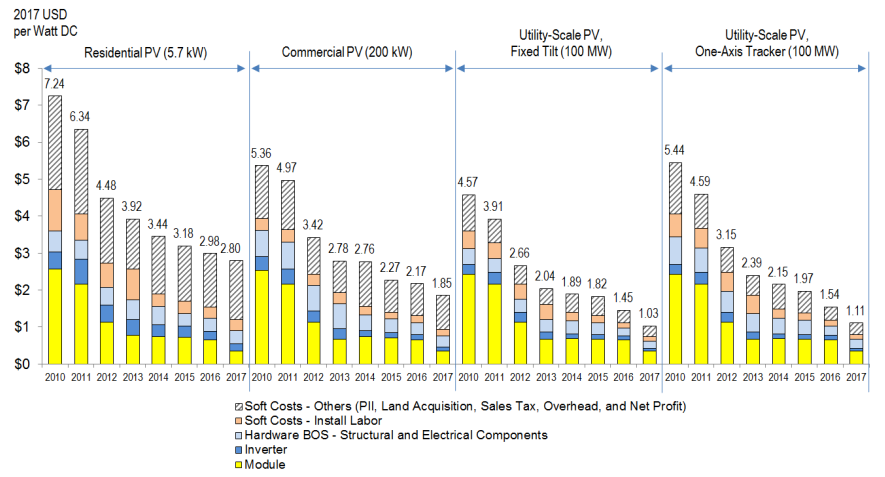
A Solar PV Balance-of-System or BOS refers to the components and equipment that move DC energy produced by solar panels through the conversion system which in turn produces AC electricity.
Most often, BOS refers to all components of a PV system other than the modules. In addition to inverters and racking, this includes the cables/wires, switches, enclosures, fuses, ground fault detectors, and more. BOS applies to all types of solar applications.
What does balance-of-system mean?
BOS components include the majority of the pieces, which make up roughly 10%-50% of solar purchasing and installation costs and account for the majority of maintenance requirements. Essentially it is through the balance-of-system components that we: control cost, increase efficiency, and modernize solar PV systems.
Costs are steadily decreasing with regard to solar panels and inverters (formerly 50% of solar PV investment costs).

Some key cost reduction aspects to consider are:
a. Bundled BOS systems (one-supplier or manufacturer) vs. gathered (several)
b. Installation - Rooftop vs. Ground-Mounted
c. Electrical Components
d. Interconnectivity / Equipment Compatibility
Less = More
Consumers turning to solar PV systems solutions are interested in:
a. Adding value to their structural property
b. Reducing expenses via utility independence
c. Systems that work seamlessly and dependably
d. Contributing personally in renewable energies
e. Aesthetics
With the right knowledge, a solar PV systems provider can guide consumer interest where state incentives and federal rebates apply to total expenditure, lower costs where rebates and incentives are not applicable, and focus on BOS efficiency within design planning and implementation.
Balance-of-systems cost and efficiency can enable business growth by way of:
a. Expansion into new sectors (i.e. Government, Schools, Non-profit, Agricultural)
b. Word of mouth recommendations
c. Creating new jobs and business locations
d. Increase training and development resources
Balance-of-Systems Efficiency
How customized planning can lead to a cost-effective and energy-efficient BOS environment.
What to look for:
- Solar Mapping to target solar power or photovoltaic potential per day, by location.
- Review utility bills with a prospective customer to help them better understand energy usage and fluctuations as well as how much they pay per kilowatt-hour.
- Inspect and recommend insulation to increase energy efficiency and rebate opportunities.
- Estimate and compare costs for rooftop and ground-mounted solar PV panels, based on optimum southern exposure.
- Calculate ways to install a solar system to determine which balance-of-systems components will be optional and which will be necessary.
- Show short-term value by adding monthly utility savings to qualifying rebates/incentives and subtracting the sum from solar PV system installation cost.
- Rely on experience to recommend low maintenance and seamless BOS operations.
*Hybrid systems combine the use of PV modules, Wind turbine, and a gas generator(s) for a grid-free power back up.
Resources:

Comments
What year was the cost breakdown of solar installation system published? Given the decline in panel prices over the past 6 months, what percentage is the BOS running of total system cost with current prices of modules? Has the BOS declined in the past 6 month? Is it projected to decline?